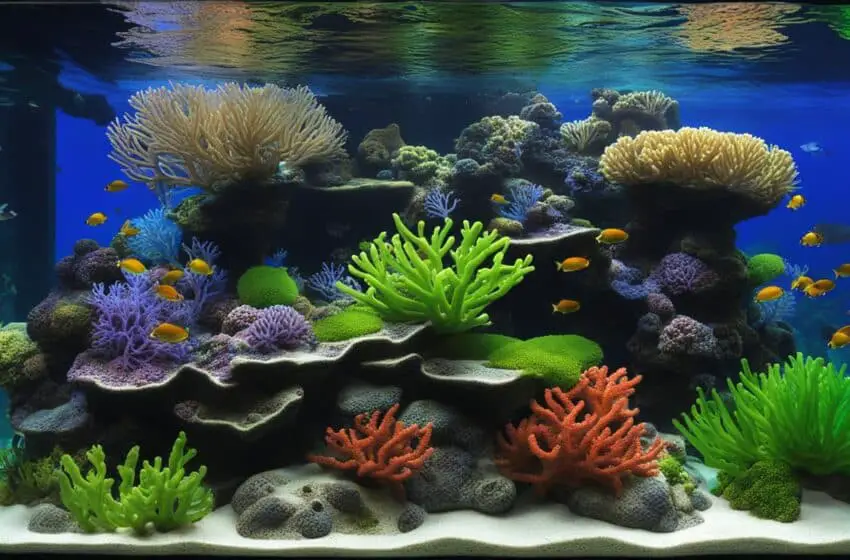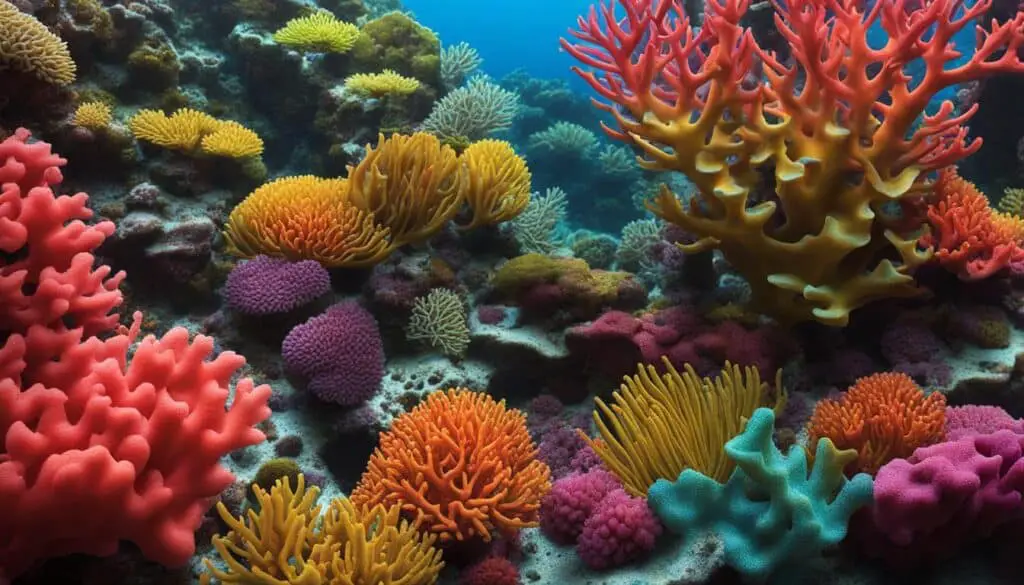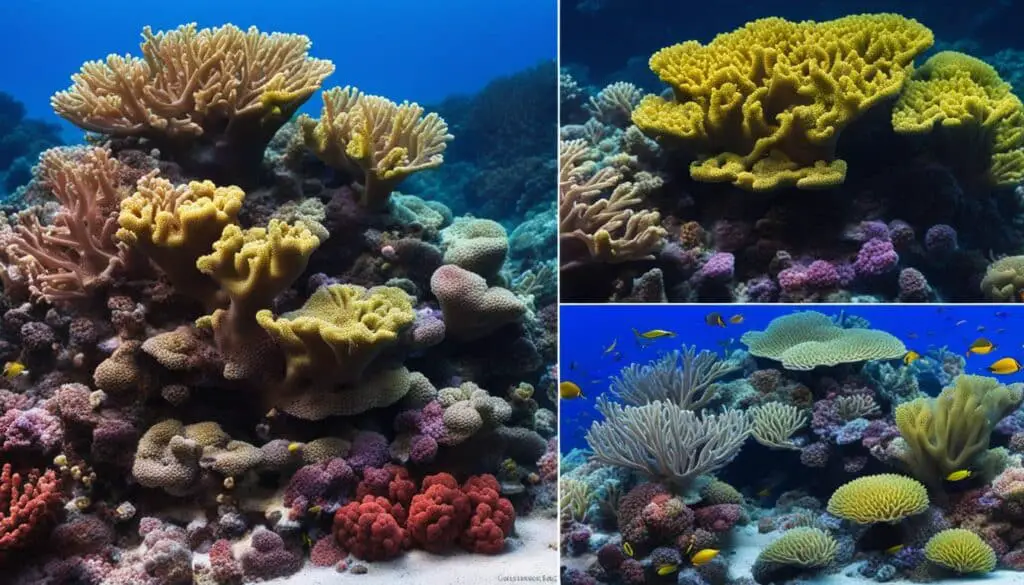Saltwater Aquarium Lighting Guide

Welcome to my comprehensive guide on saltwater aquarium lighting. In this article, I will explore the importance of lighting for coral growth and the overall health of marine ecosystems. Understanding the role of light in the symbiotic relationship between corals and zooxanthellae, as well as the different factors that influence lighting effectiveness, will help you make informed decisions for your saltwater aquarium setup.
Key Takeaways:
- Lighting plays a crucial role in coral growth and the well-being of marine ecosystems.
- Coral and zooxanthellae have a symbiotic relationship, with zooxanthellae living in coral tissues and performing photosynthesis.
- The color of light and its spectrum are important for photosynthesis and coral health.
- Light intensity should be consistent, with different corals having varying light requirements.
- LED lighting, T5 fluorescent bulbs, and metal halide lighting are popular options for saltwater aquariums, each with its own advantages and considerations.
Coral and Zooxanthellae Relationship
Corals and zooxanthellae have a fascinating symbiotic relationship. Zooxanthellae are single-celled algae that live within the tissues of coral. Through the process of photosynthesis, zooxanthellae convert sunlight into energy and produce simple sugars that serve as a food source for the coral.
This unique partnership allows corals to thrive in nutrient-poor waters by supplementing their diet with the energy-rich byproducts of photosynthesis. In return, the coral provides a protected environment and access to sunlight for the zooxanthellae to carry out their photosynthetic activities.
Corals are often described as having traits of both plants and animals due to their ability to host zooxanthellae and gain energy through photosynthesis. This remarkable symbiotic relationship is vital for the survival and growth of coral reefs, which are among the most diverse and productive marine ecosystems on the planet.
One fascinating aspect of this relationship is the ability of corals to expel zooxanthellae when faced with adverse conditions or stressors. This expulsion is most noticeable in LPS (large polyp stony) corals, where brown stringy material is released. It is a survival mechanism that allows corals to control the population of zooxanthellae or adjust to changes in their environment.
Varieties of Zooxanthellae
| Zooxanthellae Variety | Color |
|---|---|
| Cladocopium spp. | Green |
| Symbiodinium spp. | Brown |
| Durusdinium spp. | Yellow |
“The symbiotic relationship between corals and zooxanthellae is fundamental to the health and vitality of coral reefs. It is a testament to the intricate web of interactions and dependencies that exist within marine ecosystems.”
Key Points:
- Coral and zooxanthellae have a symbiotic relationship based on mutual benefit
- Zooxanthellae live within coral tissues and perform photosynthesis
- The byproducts of photosynthesis provide an energy source for the coral
- Corals can expel zooxanthellae as a means of control or adaptation
Importance of Light Color and Spectrum
The color of light plays a crucial role in both the aesthetics and the photosynthetic process of corals. It directly affects their growth and overall health. To understand why light color is important, we need to delve into the science behind chlorophyll absorption and the concept of a robust spectrum.
Chlorophyll, the pigment responsible for photosynthesis in zooxanthellae, does not absorb light uniformly. Instead, it has specific spectra of light that it absorbs highly, while others are rejected. In corals, the most common type of chlorophyll is Chlorophyll A. It has two major absorption peaks at 440nm (violet light) and 675nm (red light).
However, it’s not just these two peaks that are crucial. The spectra neighboring these peaks are also absorbed by Chlorophyll A and other compounds present in zooxanthellae. This is why lighting options should provide a robust spectrum that goes beyond just the 675nm and 440nm peaks. A robust spectrum ensures that corals receive a wide range of wavelengths that support their photosynthetic needs.
Benefits of a Robust Spectrum:
A robust spectrum of light offers several benefits to corals:
- Optimal Photosynthesis: By providing a range of wavelengths, a robust spectrum ensures that corals receive the necessary light for efficient photosynthesis. This contributes to their growth and overall health.
- Enhanced Coloration: Different wavelengths of light can enhance the natural coloration of corals. For example, certain wavelengths in the blue spectrum can intensify the fluorescent pigments in corals, resulting in vibrant and eye-catching colors.
- Better Adaptability: A robust spectrum allows corals to adapt to changing environmental conditions. Corals can adjust their photosynthetic processes by utilizing different wavelengths of light based on their needs.
Therefore, when selecting lighting options for your saltwater aquarium, it is essential to consider a robust spectrum of light. This will provide corals with the diverse range of wavelengths they require for optimal photosynthesis, coloration, and adaptability.
Understanding Color Temperature
In the world of saltwater aquarium lighting, color temperature plays a crucial role in creating the right ambiance and promoting the optimal growth of corals. The color of light is measured by a Kelvin rating, which starts at absolute zero and increases as temperature rises. The higher the Kelvin rating, the bluer the light appears. Let’s explore the concept of color temperature and its impact on the overall lighting of a saltwater aquarium.

When we think of color temperature, it’s essential to understand that higher Kelvin bulbs do not necessarily have more blue light than lower Kelvin bulbs. In fact, higher Kelvin bulbs often appear more yellow, while lower Kelvin bulbs have a yellowish hue. The blue light in higher Kelvin bulbs is achieved by reducing the red, green, and yellow phosphors, resulting in a cooler appearance.
However, the availability of blue light for photosynthesis is not determined solely by the Kelvin rating. It is entirely possible for a lower Kelvin bulb to provide more blue spectrum light than a higher Kelvin bulb. The key lies in the phosphors and the way they emit and distribute light across the spectrum.
Despite this, higher Kelvin bulbs hold aesthetic appeal and can contribute to controlling algae growth in a saltwater aquarium. They create a vibrant and visually stimulating environment, enhancing the colors of the corals and providing an enjoyable viewing experience for hobbyists.
Benefits of Understanding Color Temperature:
- Better Lighting Control: Understanding color temperature enables hobbyists to choose lighting options that align with their specific goals, whether it’s coral growth or creating a visually appealing aquarium.
- Algae Control: Higher Kelvin bulbs can help prevent excessive algae growth, maintaining a healthy and balanced saltwater ecosystem.
- Enhanced Aesthetics: Higher Kelvin bulbs bring out the natural fluorescence of corals, creating a stunning visual display in the aquarium.
By grasping the concept of color temperature and its implications for saltwater aquarium lighting, hobbyists can make informed decisions about the type and intensity of light to provide their corals.
The Importance of Light Intensity
In the past, it was believed that the brightest lighting possible was necessary for coral growth. However, recent studies have shown that coral can thrive in both bright and dimly-lit tanks. Consistency in light intensity is more important than raw intensity. Coral can grow well even in low light conditions, as long as the intensity remains consistent.
“Consistency in light intensity is more important than raw intensity.”
Light intensity is measured in PAR (photosynthetically active radiation). Different corals have different light requirements, with light-loving corals like Acropora needing higher intensity and others doing well in lower light conditions. The type of coral being kept will determine the ideal light intensity.
Effects of Light Intensity on Coral Growth
The growth of corals relies on light for photosynthesis, which provides them with energy to build calcium carbonate structures and sustain their overall health. Light intensity influences the rate of photosynthesis, which in turn affects coral growth. Higher light intensity can lead to faster growth rates in light-loving corals, while lower light intensity may slow down growth but still support healthy development.
It is essential to strike a balance with light intensity in a saltwater aquarium to ensure optimal coral growth. Maintaining consistency in light intensity throughout the day mimics natural lighting conditions and promotes healthy photosynthesis.
Customizing Light Intensity
LED lighting technology allows for precise control of light intensity. Many LED fixtures come with programmable settings that allow hobbyists to adjust the intensity levels according to the specific needs of their coral species. By tailoring the light intensity, aquarists can create the ideal environment for coral growth and maximize the beauty of their marine ecosystem.
While LED lighting is the most customizable option, other lighting technologies such as T5 fluorescent bulbs and metal halide lighting can also provide suitable light intensities for coral growth. However, it is important to consider the trade-offs in terms of energy efficiency, heat generation, and bulb lifespan.

Lighting Technologies for Saltwater Aquariums
When it comes to lighting saltwater aquariums, there are several technologies to choose from, each with its own advantages and drawbacks. The three most commonly used lighting technologies are LED lighting, T5 fluorescent bulbs, and metal halide lighting.
LED Lighting
LED lighting has become the most popular choice among saltwater aquarium enthusiasts due to its versatility and energy efficiency. LEDs can be controlled individually, allowing hobbyists to customize the lighting schedule, colors, and intensity according to their preferences. Additionally, LEDs bring out the vibrant fluorescence in corals, enhancing their visual appeal.
One advantage of LED lighting is that it runs cooler than other lighting options, reducing the risk of overheating the tank. However, it’s important to note that some corals may not display their optimal colors under LED lighting. Additionally, while LEDs themselves can have a long lifespan, LED fixtures may have a shorter longevity, so it’s important to choose reliable and well-built options.
T5 Fluorescent Bulbs
T5 fluorescent bulbs offer a wide range of aesthetic options and produce a robust light spectrum that is beneficial for the growth of corals. These bulbs come in different colors and intensities, allowing hobbyists to create pleasing visual effects in their aquariums. However, T5 fluorescent bulbs have a shorter lifespan compared to LEDs, and they are less energy-efficient.
Metal Halide Lighting
Metal halide lighting is known for its intense brightness, making it a great choice for light-loving corals. This technology promotes the growth of corals that require high light intensity to thrive, such as Acropora. However, metal halide lighting generates more heat and consumes more energy than other options. Proper ventilation and temperature regulation are essential when using metal halide lights to prevent overheating the tank.
In conclusion, when selecting a lighting technology for a saltwater aquarium, it’s essential to consider factors such as customization options, energy efficiency, color rendition, and the light requirements of the corals being kept. LED lighting offers the most versatility and energy efficiency, T5 fluorescent bulbs provide a wide range of aesthetic options, and metal halide lighting is best suited for light-loving corals. By choosing the right lighting technology, hobbyists can create the optimal lighting conditions for a vibrant and thriving saltwater aquarium.
Conclusion
Choosing the right lighting for your saltwater aquarium is essential for the growth and well-being of your corals. By understanding the symbiotic relationship between corals and zooxanthellae, as well as the importance of light color and spectrum, and factors of light intensity and different lighting technologies, you can create the optimal lighting conditions for a thriving marine ecosystem.
LED lighting is a popular choice that offers both customization and energy efficiency. With individual control over the schedule, colors, and intensity of the light, LED lights allow you to tailor the lighting to your specific needs. However, it’s important to note that some corals may not color up as well under LED lighting.
Another option to consider is T5 fluorescent bulbs, which provide a wide range of aesthetic options and produce a robust spectrum of light. While they may have a shorter bulb life and lower energy efficiency compared to LEDs, they can still be a great choice for your aquarium.
If you have light-loving corals and want to promote their growth, metal halide lighting can be a suitable option. It provides intense light, but it’s important to be mindful of the higher heat generation and energy consumption associated with this lighting technology.
In the end, the choice of lighting technology for your saltwater aquarium will depend on your personal preferences, the coral species you have, and your desired coral growth outcomes. By considering these factors and making an informed decision, you can create an ideal lighting environment for your saltwater aquarium.
FAQ
What is the relationship between coral and zooxanthellae?
Coral and zooxanthellae have a symbiotic relationship in which zooxanthellae live in coral tissues and perform photosynthesis. The byproducts of photosynthesis serve as an energy source for the coral.
Why do corals expel their zooxanthellae?
Corals can occasionally expel zooxanthellae to control their population or adjust to changes in the environment. This is most noticeable in LPS corals where brown stringy material is expelled. The bleaching of natural coral reefs occurs when corals expel their zooxanthellae as a last resort to survive changing conditions.
Why is the color of light important for corals?
The color of light is important for both aesthetics and the photosynthetic process. Chlorophyll in zooxanthellae absorbs certain spectra of light more than others, so it is important for lighting options to provide a robust spectrum of light beyond just the 675nm and 440nm peaks.
How is the color of light measured?
The color of light is measured by a Kelvin rating, which starts at absolute zero and increases as temperature rises. Higher Kelvin bulbs are aesthetically pleasing and can help control algae growth, while lower Kelvin bulbs promote faster coral growth.
Is light intensity more important than raw intensity for coral growth?
Consistency in light intensity is more important than raw intensity. Different corals have different light requirements, but as long as the light intensity remains consistent, coral can grow well even in low light conditions.
What are the different lighting technologies for saltwater aquariums?
The most popular lighting technology for saltwater aquariums is LED lighting, which offers customization and energy efficiency. T5 fluorescent bulbs provide a wide range of aesthetic options, but have shorter bulb life and lower energy efficiency. Metal halide lighting is the most intense option for light-loving corals, but it may generate more heat and higher energy consumption.



